As a new year approaches, we take a little look back…

It has been a turbulent year – and not just in politics. Here at Bodnant Garden we’ve had our share of weather dramas but we’ve managed to rise above a series of stormy setbacks to enjoy some real highs – achieving major work in the garden, welcoming more visitors than ever and even picking up a couple of awards along the way.
We opened the year by launching our new guidebook (modelled above by our volunteer Den) updated with recent historical discoveries that we’ve been making from the archives. In February we welcomed lots of families for half term with our ever-popular snowdrop planting; this year we also set up a Plant Hunters expedition camp at the Old Mill for young explorers (like our volunteer Gethin here) which proved really popular.

But February also brought an unwelcome visitor – Storm Doris. Gales wreaked havoc in the garden, ripping up trees and leaving debris.
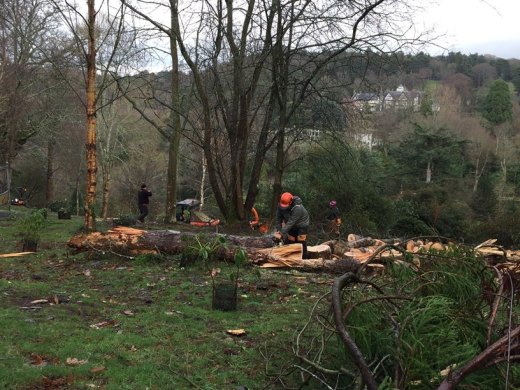
Especially badly affected was Furnace Hill, a new area we were readying to open to the public. With just a month to go until the grand opening the team (Nathan, Maxine, Alex, Fiona, Steve and Christina, seen below) had to grit their teeth and begin a massive clear-up operation throughout March.


They did it. After an amazing effort by gardeners and volunteers, on April 11 the ropes came down, a ceremonial log was chain-sawed, and hundreds of visitors entered Furnace Wood and Meadow for the first time. TV naturalist Iolo Williams joined us and lead a mass, celebratory daffodil planting in the meadow.
There followed a period of calm after the storm, bringing a beautiful spring. Many plants flowered a little earlier than usual, from the daffodils in March to the famous Laburnum Arch in late May, which was in bloom a good week before expected. Visitors flocked to enjoy the fabulous old rhododendrons in Furnace Wood, and picnic in the meadow for the first time.

 Elsewhere in the garden work continued planting up the new North Garden woodland beds and the Himalayan poppies and primulas were flowering in recently redesigned beds alongside the Pin Mill. Fantastic flower displays weren’t the only things catching visitors’ eyes – the family of Canada Geese at the Far End were the focus of much admiration and many photographs too.
Elsewhere in the garden work continued planting up the new North Garden woodland beds and the Himalayan poppies and primulas were flowering in recently redesigned beds alongside the Pin Mill. Fantastic flower displays weren’t the only things catching visitors’ eyes – the family of Canada Geese at the Far End were the focus of much admiration and many photographs too.

 After the heady highlight of the arch, Bodnant Garden won Best Garden Renovation (for The Bath), as well as runner up for Best Volunteer Project (Laburnum Archers) in the prestigious industry Horticulture Week Awards – Charlie, Lynne and Fran enjoying a trip to the ceremony at Woburn Abbey in June to represent the team.
After the heady highlight of the arch, Bodnant Garden won Best Garden Renovation (for The Bath), as well as runner up for Best Volunteer Project (Laburnum Archers) in the prestigious industry Horticulture Week Awards – Charlie, Lynne and Fran enjoying a trip to the ceremony at Woburn Abbey in June to represent the team.
In July we bid a fond farewell to our Visitor Services Manager Ann Smith, who retired after more than 30 years with Bodnant Garden. In a fitting tribute, as a leaving gift we named a unique rhododendron after her, which means she’ll always have a place here at the garden. We also welcomed our new Visitor Experience Manager (below right).



The children of Eglwysbach School helped us celebrate National Meadows Day with a visit to Furnace in sunny July. We also took a little bit of Bodnant Garden’s meadows to the National Eisteddfodd on Anglesey in August, as part of a National Trust Wales exhibition. It was a combined effort from staff and volunteers across North West Wales, (like our Andy, below) who ran the week-long event, meeting and greeting visitors… in the face of torrential downpours which opened the school holiday season!

And so began a fun-packed, if slightly damp summer of family events at Bodnant Garden, highlights including a workshop with North Wales Embroiderers Guild, and an unforgettable afternoon with Denbighshire Music Co-Operative who gave us a garden party on the Canal Terrace.

September brought better weather and a lovely display of late summer flowers (plus an unusual number of late butterflies too). We launched our first Silent Space at the Arboretum in September, encouraging visitors to enjoy perfect peace and quiet. Elsewhere, lively chatter was most definitely allowed, with our volunteers leading a new series of guided tours in the Welsh language.
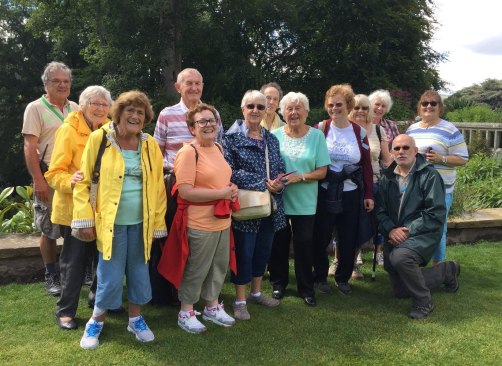
 As schools returned we welcomed our own new horticultural student at Bodnant Garden – Julie (seen right) swapped her catering uniform for garden gear as she moved across from working at the Pavilion tearoom to being part of the garden team. Autumn also brought two more additions to the garden team with the appointment of supervisors Merlin and Ann (seen below).
As schools returned we welcomed our own new horticultural student at Bodnant Garden – Julie (seen right) swapped her catering uniform for garden gear as she moved across from working at the Pavilion tearoom to being part of the garden team. Autumn also brought two more additions to the garden team with the appointment of supervisors Merlin and Ann (seen below).

 In the autumn Bodnant Garden’s 51-metre Coast Redwood in the Dell was runner up for the title Tree of the Year in a competition by the Woodland Trust (the eventual worthy winner was the Hollow Oak at Gnoll Estate Country Park). Thankfully our veteran tree, a Welsh Champion, was not damaged in Storms Ophelia and Brian which followed in October, but in their wake they left another clean-up operation for our garden team. In spite of the damage and debris, the team managed to make the garden safe and tidy for half term, so that we were able to go ahead with our autumn and half term Treefest celebrations.
In the autumn Bodnant Garden’s 51-metre Coast Redwood in the Dell was runner up for the title Tree of the Year in a competition by the Woodland Trust (the eventual worthy winner was the Hollow Oak at Gnoll Estate Country Park). Thankfully our veteran tree, a Welsh Champion, was not damaged in Storms Ophelia and Brian which followed in October, but in their wake they left another clean-up operation for our garden team. In spite of the damage and debris, the team managed to make the garden safe and tidy for half term, so that we were able to go ahead with our autumn and half term Treefest celebrations.
In November it was ‘glad rags’ on as we celebrated more award successes – a first for our work at Parc Farm at the PR Week Awards in London (attended by manager William and farmer Dan), Best Attraction at the Welsh Hospitality Awards in Cardiff (attended by catering manager Ailsa) and runner-up for Best Attraction and Green Award at the Go North Wales awards in Llandudno (attended by Visitor Welcome staff Rachel and Pip).
Fresh from storm clearance, gardeners progressed with other work in November, completing the new planting of the Canal Terrace borders and taking down a row of Lawson Cypress on the East Garden. Both areas have been newly designed and should be flowering in 2018, so watch this space.

The team managed to get their work done just in time before the heavens opened and snow descended in December. The garden was closed for a day while gardeners set to, once again, clearing paths to welcome pre-Christmas visitors but thankfully no major damage was done…and the dusting of white made for some magical photographs.

And so to 2018…we’re working towards opening the third of our meadows, Cae Poeth, next year and seeing all the new design work around the garden developing. We’ll also be marking the national centenary of Women’s Suffrage – celebrating Bodnant’s donor family who played a pivotal role in the fight to secure votes for women. We’ll be sharing more about the history behind the garden over the course of next year here on the blog, on our website and social media, and around the garden itself.
Thank you everyone for visiting the garden and following us in 2017 – your support helps the National Trust look after this very special place. We wish you all a Happy New Year!
For more details about Bodnant Garden call 01492 650460, check out our website nationaltrust.org.uk/bodnant-garden or find us on Facebook, Twitter and Instagram



 If you’re a follower of Bodnant Garden on social media you may have seen the work of photographer Julie Pigula – most likely through her pictures of dog Bailey, one of our regular #WagWednesday visitors.
If you’re a follower of Bodnant Garden on social media you may have seen the work of photographer Julie Pigula – most likely through her pictures of dog Bailey, one of our regular #WagWednesday visitors.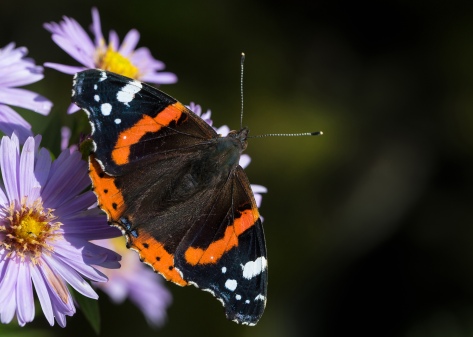


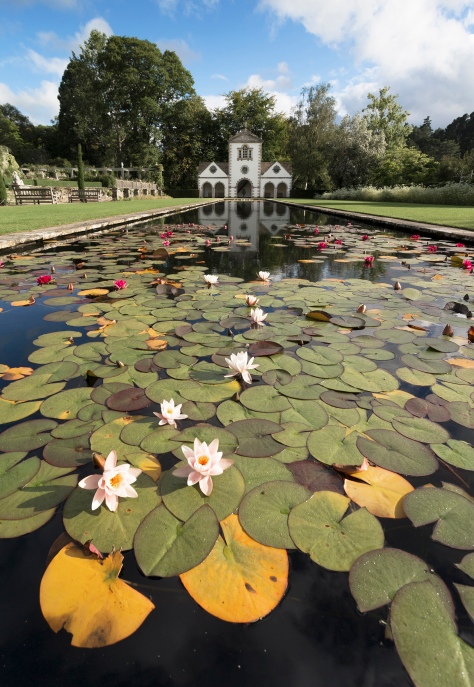

 Garden photography is not just a summer hobby; Bodnant Garden is now open all year round. Spring brings not only daffodils but trees with beautiful blossom. Who could resist the swathes of azaleas and rhododendrons or the beauty of emerging new leaves in pristine condition to be captured by a lens? Summer and the garden is filled with colour in the Rose Terraces; autumn is also a great time to be out with the camera and the Acer Glade, in particular, looks spectacular. Winter brings snow and frost which bring a whole new dimension to garden photography and the Winter Garden has been planted specifically to show off winter trees and shrubs. From the beautiful barks of the white birches to the red stems of the dogwood. You will be amazed how much there is to photograph.
Garden photography is not just a summer hobby; Bodnant Garden is now open all year round. Spring brings not only daffodils but trees with beautiful blossom. Who could resist the swathes of azaleas and rhododendrons or the beauty of emerging new leaves in pristine condition to be captured by a lens? Summer and the garden is filled with colour in the Rose Terraces; autumn is also a great time to be out with the camera and the Acer Glade, in particular, looks spectacular. Winter brings snow and frost which bring a whole new dimension to garden photography and the Winter Garden has been planted specifically to show off winter trees and shrubs. From the beautiful barks of the white birches to the red stems of the dogwood. You will be amazed how much there is to photograph.





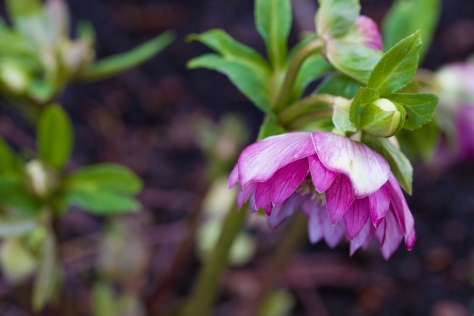



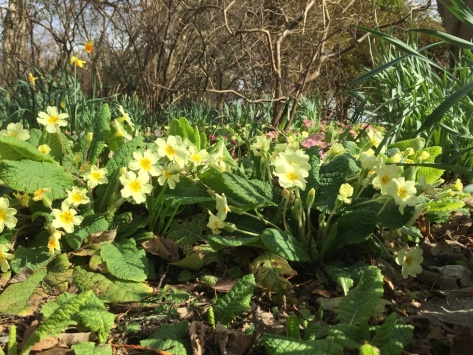





 Property manager William Greenwood (seen above, cutting the enormous cake – courtesy of our catering team) said: “Wow. I really can’t believe it. A quarter of a million visitors – and counting – in a single year. We’ve said ‘Hello’ and ‘Bore da’ 250,000 times. We’ve helped park cars, made countless cups of tea and sold thousands of home-made scones. We’ve run events and activities throughout the holidays, welcomed hundreds of happy dogs (and owners). We’ve opened more of the garden than ever before and are developing and refreshing even more.
Property manager William Greenwood (seen above, cutting the enormous cake – courtesy of our catering team) said: “Wow. I really can’t believe it. A quarter of a million visitors – and counting – in a single year. We’ve said ‘Hello’ and ‘Bore da’ 250,000 times. We’ve helped park cars, made countless cups of tea and sold thousands of home-made scones. We’ve run events and activities throughout the holidays, welcomed hundreds of happy dogs (and owners). We’ve opened more of the garden than ever before and are developing and refreshing even more.







 Our head gardener John Rippin was able to give the well-known horticulturists Bob Flowerdew, Mathew Biggs, Pippa Greenwood and Eric Robson a little pre-show tour of the garden. Mother Nature obligingly set the scene – during the late afternoon the chill wind dropped, clouds parted, even the sun showed itself and (I kid you not) bird song filled the frosty air.
Our head gardener John Rippin was able to give the well-known horticulturists Bob Flowerdew, Mathew Biggs, Pippa Greenwood and Eric Robson a little pre-show tour of the garden. Mother Nature obligingly set the scene – during the late afternoon the chill wind dropped, clouds parted, even the sun showed itself and (I kid you not) bird song filled the frosty air. Invigorated (if a little breathless…but the walk to the Dell viewpoint was declared well worth it) our guests then returned to a full house at the Pavilion tearoom where they expertly rattled their way through audience questions, with trademark warmth and humour, providing their thoughts on topics from whether to prune an overgrown magnolia (NO!), to how gardening can tend the troubled soul.
Invigorated (if a little breathless…but the walk to the Dell viewpoint was declared well worth it) our guests then returned to a full house at the Pavilion tearoom where they expertly rattled their way through audience questions, with trademark warmth and humour, providing their thoughts on topics from whether to prune an overgrown magnolia (NO!), to how gardening can tend the troubled soul.

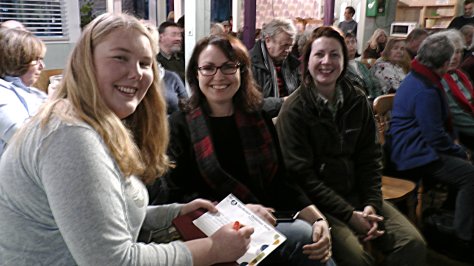







 Elsewhere in the garden work continued planting up the new North Garden woodland beds and the Himalayan poppies and primulas were flowering in recently redesigned beds alongside the Pin Mill. Fantastic flower displays weren’t the only things catching visitors’ eyes – the family of Canada Geese at the Far End were the focus of much admiration and many photographs too.
Elsewhere in the garden work continued planting up the new North Garden woodland beds and the Himalayan poppies and primulas were flowering in recently redesigned beds alongside the Pin Mill. Fantastic flower displays weren’t the only things catching visitors’ eyes – the family of Canada Geese at the Far End were the focus of much admiration and many photographs too.
 After the heady highlight of the arch, Bodnant Garden won Best Garden Renovation (for The Bath), as well as runner up for Best Volunteer Project (Laburnum Archers) in the prestigious industry Horticulture Week Awards – Charlie, Lynne and Fran enjoying a trip to the ceremony at Woburn Abbey in June to represent the team.
After the heady highlight of the arch, Bodnant Garden won Best Garden Renovation (for The Bath), as well as runner up for Best Volunteer Project (Laburnum Archers) in the prestigious industry Horticulture Week Awards – Charlie, Lynne and Fran enjoying a trip to the ceremony at Woburn Abbey in June to represent the team.





 As schools returned we welcomed our own new horticultural student at Bodnant Garden – Julie (seen right) swapped her catering uniform for garden gear as she moved across from working at the Pavilion tearoom to being part of the garden team. Autumn also brought two more additions to the garden team with the appointment of supervisors Merlin and Ann (seen below).
As schools returned we welcomed our own new horticultural student at Bodnant Garden – Julie (seen right) swapped her catering uniform for garden gear as she moved across from working at the Pavilion tearoom to being part of the garden team. Autumn also brought two more additions to the garden team with the appointment of supervisors Merlin and Ann (seen below).
 In the autumn Bodnant Garden’s 51-metre Coast Redwood in the Dell was runner up for the title Tree of the Year in a competition by the Woodland Trust (the eventual worthy winner was the Hollow Oak at Gnoll Estate Country Park). Thankfully our veteran tree, a Welsh Champion, was not damaged in Storms Ophelia and Brian which followed in October, but in their wake they left another clean-up operation for our garden team. In spite of the damage and debris, the team managed to make the garden safe and tidy for half term, so that we were able to go ahead with our autumn and half term Treefest celebrations.
In the autumn Bodnant Garden’s 51-metre Coast Redwood in the Dell was runner up for the title Tree of the Year in a competition by the Woodland Trust (the eventual worthy winner was the Hollow Oak at Gnoll Estate Country Park). Thankfully our veteran tree, a Welsh Champion, was not damaged in Storms Ophelia and Brian which followed in October, but in their wake they left another clean-up operation for our garden team. In spite of the damage and debris, the team managed to make the garden safe and tidy for half term, so that we were able to go ahead with our autumn and half term Treefest celebrations.





 It’s always sad to lose old faces in the garden landscape but the trees, thought to be 30-40 years old, were not in the best health and had grown so large that they were putting a strain on nearby walls – as well as shading out everything in surrounding beds. Now they are gone, already a new vista has opened up from the Top Lawn across the Front Lawn towards the Carneddau Mountains.
It’s always sad to lose old faces in the garden landscape but the trees, thought to be 30-40 years old, were not in the best health and had grown so large that they were putting a strain on nearby walls – as well as shading out everything in surrounding beds. Now they are gone, already a new vista has opened up from the Top Lawn across the Front Lawn towards the Carneddau Mountains.

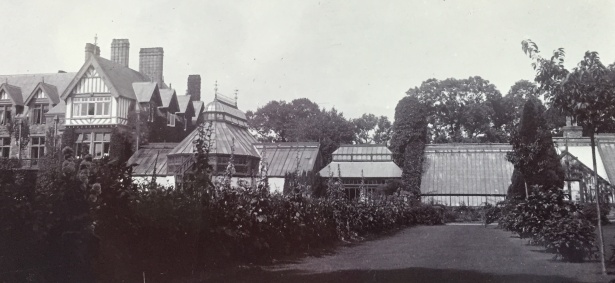

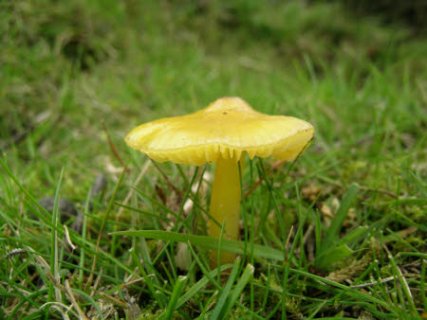











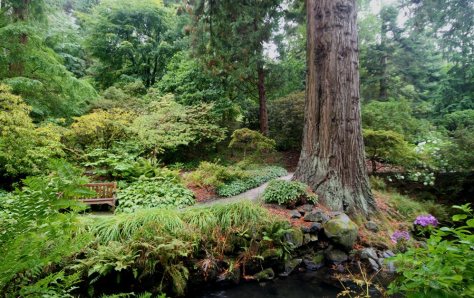 Our Coast Redwood in The Dell is in the Wales finals for the
Our Coast Redwood in The Dell is in the Wales finals for the 


